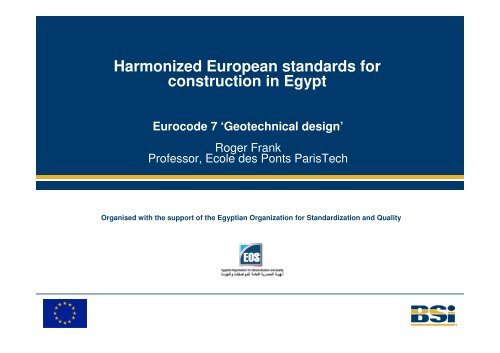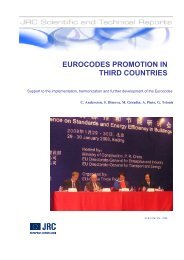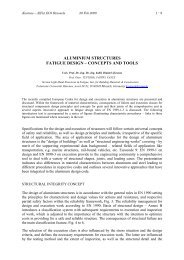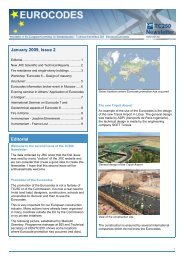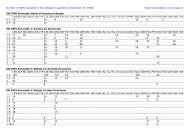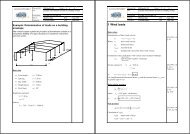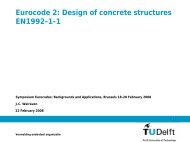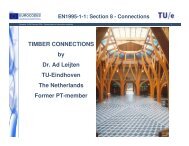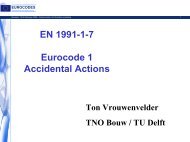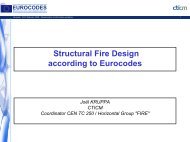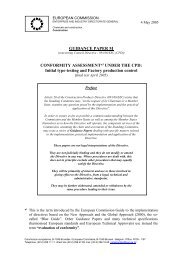EC 7: Geotechnical Design - Eurocodes
EC 7: Geotechnical Design - Eurocodes
EC 7: Geotechnical Design - Eurocodes
- No tags were found...
Create successful ePaper yourself
Turn your PDF publications into a flip-book with our unique Google optimized e-Paper software.
2Outline1. Introduction2. Contents of Eurocode 7 - Parts 1 & 23. Some aspects of Eurocode 7-1Characteristic valuesULS <strong>Design</strong> ApproachesSLS –Serviceability limit states4. Liaisons. Associated standardsHarmonized European standards for construction in Egypt
STRUCTURAL EUROCODESEN 1990EN 1991Structural safety,serviceability anddurabilityActions onstructures3EN 1992 EN 1993 EN 1994EN 1995 EN 1996 EN 1999<strong>Design</strong> anddetailingEN 1997 EN 1998<strong>Geotechnical</strong>and seismicdesignHarmonized European standards for construction in Egypt
4Eurocode 7 – <strong>Geotechnical</strong> design• EN 1997-1 1 (2004) : General rules• EN 1997-2 2 (2007) : Ground investigationand testingHarmonized European standards for construction in Egypt
52. Contents of Eurocode 7 –Parts 1 & 2Harmonized European standards for construction in Egypt
Contents of Part 1 (EN 1997-1)6• Section 1 General• Section 2 Basis of geotechnicaldesign• Section 3 <strong>Geotechnical</strong> data• Section 4 Supervision ofconstruction, monitoring andmaintenance• Section 5 Fill, dewatering, groundimprovement and reinforcementHarmonized European standards for construction in Egypt
7• Section 6 Spread foundations• Section 7 Pile foundations• Section 8 Anchorages• Section 9 Retaining structures• Section 10 Hydraulic failure• Section 11 Site stability• Section 12 EmbankmentsHarmonized European standards for construction in Egypt
Informative annexes8Annexe C – Passive earthpressureAnnex CActiveearthpressureAnnexes D & E : Bearing capacity offoundationsR/A' = c' × N c× b c× s c× i c+q' × N q× b q× s q× i q+R /A' = σ v0+ k × p* le0,5 × γ' × B '× N γ× b γ× s γ× i γAnnexe F : Settlement of foundationss = p × b × f / E mHarmonized European standards for construction in Egypt
• Section 1 GeneralContents of Part 2 (EN 1997-2)• Section 2 Planning and reporting ofground investigations• Section 3 Drilling, sampling and gwmeasurements• Section 4 Field tests in soils androcks• Section 5 Laboratory tests on soilsand rocks• Section 6 Ground investigation report> Also a number of Informative annexes9Harmonized European standards for construction in Egypt
EN 1997- 2Field tests in soils and rocks (Section 4)10Clauses on :CPT(U), PMT, FDT, SPT, DP, WST, FVT, DMT, PLT Objectives, specific requirements, evaluation of testresults, use of test results and derived valuesAnnexes with examples on use of results and derivedvalues for geotechnical designHarmonized European standards for construction in Egypt
EN 1997- 2Lab. tests on soils and rocks (Section 5) preparation of soil specimens for testing preparation of rock specimens for testing tests for classification, identification and description of soils chemical testing of soils and groundwater strength index testing of soils strength testing of soils compressibility and deformation testing of soils compaction testing of soils permeability testing of soils tests for classification of rocks swelling testing of rock material strength testing of rock material11Harmonized European standards for construction in Egypt
Results of test standards (EN 1997-2 Annex A)12Field testCPT/CPTUDynamic probingSPTPressuremeters (PMT)Flexible dilatometer (FDT)Field vane test (FVT)Weight sounding test (WST)Plate loading testFlta dilatometer testTest resultsq c , f s , R f (CPT) / q t , f s , u (CPTU)N 10 (DPL, DPM, DPH); N 10 or N 20 (DPSH)N , E r (SPT), soil descriptionE M , , p f , p lM (MPM); expansion curve (all)E FDT , deformation curvec fv , c rv , torque-rotation curvecontinuous record of penetration depth or N bp uP 0 , p 1 , E DMT , I DMT , K DMT (DMT)Laboratory testsSoils: w ; ρ ; ρ s ; grain size distribution curve ; w P , w L ; e max , e min , I D ; C OM ; C CaCO3 ; C SO42-, C SO32-; C cl ; pH ;compressibility, consolidation, creep curves, E oed , σ’ p or C s , C c , σ’ p , C α ; c u (lab vane) ; c u (fall cone) ; q u ; c u (UU) ;σ-ε and u curves, σ−paths, Mohr circles ; c’, ϕ’ or c u , c u =f(σ’c), E’ or E u ; σ-u curve, τ-σ diagram, c’, ϕ’, residualparameters ; I CBR ; k (direct lab, field or oedometer)Rocks: w ; ρ and n ; swelling results ; σ c , E and ν ; I s50 ; σ-u curve, Mohr diagram, c’, ϕ’, res par ; σ T ; σ-ε curve,σ−paths, Mohr circles ; c’, ϕ’, E and νHarmonized European standards for construction in Egypt
Type of testF= field L= laboratory<strong>Geotechnical</strong> propertiesF 1 F 2 L 1 L 213CorrelationsTest results andderived valuesEN 1997 -2EN 1997 -1C1 C21 2 3 4Cautious selectionInformationfrom othersources onthe site, thesoils androcks andthe project<strong>Geotechnical</strong> model and characteristicvalue of geotechnical propertiesApplication ofpartial factors<strong>Design</strong> values of geotechnicalpropertiesHarmonized European standards for construction in Egypt
143. Some aspects of Eurocode 7-1Characteristic valuesand design valuesULS <strong>Design</strong> ApproachesSLS and deformations of structuresHarmonized European standards for construction in Egypt
Characteristic valueof geotechnical parameters15P The characteristic value of a geotechnical parameter shallbe selected as a cautious estimate of the value affectingthe occurrence of the limit state.If statistical methods are used, the characteristic valueshould be derived such that the calculated probability of aworse value governing the occurrence of the limit stateunder consideration is not greater than 5%.Harmonized European standards for construction in Egypt
16<strong>Design</strong> values of geotechnical parameters<strong>Design</strong> value of a parameter : X d = X k / γ M<strong>Design</strong> values of actions and resistancesfulfilling for STR/GEO ULS : E d ≤ R dorE d = E {γ F .F k } and R d = R { X k / γ M }(= “at the source”)E d = γ E .E { F k } and R d = R { X k } / γ RHarmonized European standards for construction in Egypt
Ultimate limit states – Eurocode 7-117EQU : loss of equilibrium of the structureSTR : internal failure or excessive deformationof the structure or structural elementsGEO : failure or excessive deformation of thegroundUPL : loss of equilibrium due to uplift by waterpressure (buoyancy) or other vertical actionsHYD : hydraulic heave, internal erosion andpiping caused by hydraulic gradientsHarmonized European standards for construction in Egypt
EN1990 - Ultimate limit statesEQU and STR/GEO18E d < R dJ.A CalgaroHarmonized European standards for construction in Egypt
STR/GEO : ULS - persistent and transient situationsApproaches123CombinationsA1 “+” M1 “+” R1&A2 “+” M2 “+” R1Or A2 “+” M1 or M2“+” R4A1 “+” M1 “+” R2A1 or A2 “+” M2 “+” R3E d < R dAction (γ F)PermanentUnfavourableFavourableVariableUnfavourableFavourableSoil parameter (γ M)Angle of shearing resistanceEffective cohesionUndrained shear strengthUnconfined strengthSymbolγ Gγ Gγ Qγ QSymbolγ ϕ’γ c’γ cuγ quSet A11,351,001,500Set M11,001,001,001,00Set A21,001,001,300Set M21,251,251,401,4019Weight densityγ γ1,001,00Resistance (γ R)Bearing capacitySlidingSymbolγ Rvγ RhSet R11,001,00Set R21,41,1Set R31,001,00 γ R for SpreadfoundationsHarmonized European standards for construction in Egypt
Ultimate limit states (UPL)20buriedhollowstructureWatertightsurfaceTbWTTAnchoredstructureWPTAnchorageSandWatertightsurfaceslab belowwater levelSandInjected sandSanduuExamples of situations whereuplift might be criticalG dst;d+ Q dst;d ≤ G stb;d+ R dFormer ground surfaceSandbSandσ vW atertight surfaceulightweightembankmentduring floodbottom Clay ofanexcavationGravelWuClayClayGravelHarmonized European standards for construction in Egypt
Ultimate limit states (HYD)21Heave duetoseepageof waterWaterlowpermeabilitysoilpiezometric level inthe permeablesubsoilPermeablesubsoilPipingSandu dst;d ≤σ stb;d∆u dst;d≤ σ´stb;dExample of situation whereheave or piping might be criticalHarmonized European standards for construction in Egypt
22Accidental situationsActions : all values of γ F (and γ M ) = 1.0Resistances :all values of γ R (and γ M ) dependon the particular accidentSeismic situations : see Eurocode 8-5Harmonized European standards for construction in Egypt
Ultimate limitVerifications of ULSlimit states of static equilibrium (EQU) :23E d,dst ≤ E d,stbUltimate limit states of resistance (STR/GEO) :E d ≤ R dUltimate limit state of uplift (UPL) :G dst;d + Q dst;d ≤ G stb;d + R dUltimate limit state of hydraulic failure (HYD) :u dst;d ≤ σ stb;dor S dst;d ≤ G´stb;dHarmonized European standards for construction in Egypt
EN1990 - Serviceability limit statesVerifications :SLS24E d ≤ C dC d = limiting design value of the relevantserviceability criterionE d = design value of the effects of actionsspecified in the serviceability criterion, determinedon the basis of the relevant combinationall γ F and γ M = 1.0Harmonized European standards for construction in Egypt
Movements and deformationsdeformations of25structuress maxδ s max• settlement s, differentialsettlement δs, rotation θand angular strain α• relative deflection ∆ anddeflection ratio ∆/L• ω and relative rotation(angular distortion) β(after Burland and Wroth,1975)Harmonized European standards for construction in Egypt
Foundations of buildings (Eurocode 7, 1994)* Serviceability limit states (SLS) : β max ≈ 1/500* Ultimate limit states (ULS) : β max ≈ 1/150• s max ≈ 50 mm δ smax ≈ 20 mm26Foundations of bridgesMoulton (1986) for 314 bridges in the US and Canada :* β max ≈ 1/250 (continuous deck bridges)and β max ≈ 1/200 (simply supported spans)* s Hmax ≈ 40 mmIn France, in practice :ULS : β max ≈ 1/250SLS : β max ≈ 1/1000 à 1/500Harmonized European standards for construction in Egypt
4. Liaisons. Associated standards• EN 1990: Eurocode : Basis of structuraldesign• <strong>EC</strong> 8 - 5 : Earthquake resistance design:foundations, retaining structuresand geotechnical aspects• TC 288 : Execution of geotechnical works• TC 341 : <strong>Geotechnical</strong> investigation andtesting• ISO/TC 182 Geotechnics :SC1 Soil and rock classificationSC3 Foundations, retaining structures &earthworks27Harmonized European standards for construction in Egypt
Execution of geotechnical works – TC 288Published standardsEN 1536EN 1538EN 1537EN 12063EN 12699EN 12715EN 12716EN 14199: Bored piles (1999), 79 p: Diaphragm walls (2000), 46 p: Ground anchors (2000), 56 p: Sheet piling (1999), 76 p: Displacement piles (2001), 45 p: Grouting (2000), 49 p: Jet-grouting (2001), 36 p: Micropiling (2005), 45 pEN 14475 : Reinforcement of fills (2007), 49EN 14490 : Soil Nailing (2010)EN 14679EN 14731EN 15237(October 2010): Deep mixing (2005), 49 p: Deep vibration (2006), 22 p: Deep vertical drainage(2007), 52 p28Harmonized European standards for construction in Egypt
Investigation and laboratory testingPublished documents as of April 2010 (TC 341)Standards (4) – Short title (date of publication)EN ISO 14688-1 : Identification of soils (2002-08)EN ISO 14688-2 : Classification of soils (2004-07)EN ISO 14689-1 : Identification of rock (2003-12)EN ISO 22475-1 : Sampling - principles (2006-9)Technical specifications (12)TS 22475-2 : Sampling - qualification criteria (2006-9)TS 22475-3 : Sampling – conformity assessment (2007-12)TS 17892-1 to 12 (2004-11) to be replaced by ENs:Water content, Density of fine grained soils,Density of solid particles, Particle size distribution,Oedometer test, Fall cone test,Unconfined compression test,Unconsolidated triaxial test,Consolidated triaxial test,Direct shear test,Permeability test,Atterberg Limits29Harmonized European standards for construction in Egypt
Field (in situ) testingPublished documents as of 1 st April 2010 (TC 341)30Published standards (4) – Short title (date of publication)EN ISO 22476-2 : Dynamic probing (2005-01)EN ISO 22476-3 : Standard penetration test (2005-01)Published technical specifications (2)TS 22476-10 : Weight sounding test (2005-05)TS 22476-11 : Flat dilatometer test (2005-05)SPTWSTDMTDPHarmonized European standards for construction in Egypt
Eurocode 7 is :Conclusions31- a tool to help European geotechnical engineers speakthe same language- a necessary tool for the dialogue between geotechnicalengineers and structural engineersEurocode 7 helps promoting research- it stimulates questions on present geotechnicalpractice from ground investigation to design modelsHarmonized European standards for construction in Egypt
32and to really conclude :• It should be considered that knowledge of the groundconditions depends on the extent and quality of thegeotechnical investigations. Such knowledge and thecontrol of workmanship are usually more significant tofulfilling the fundamental requirements than isprecision in the calculation models and partial factors.Harmonized European standards for construction in Egypt
33Thank you for your attention !Harmonized European standards for construction in Egypt
34Contact UsName of Speaker:Title:Organisation:Email:Links:Roger FrankProfessorEcole des Ponts ParisTechfrank@cermes.enpc.frwww.bsigroup.comProject Team Leader:Email:Links:Keith Moyeskeith.moyes@bsigroup.comwww.bsigroup.comHarmonized European standards for construction in Egypt


